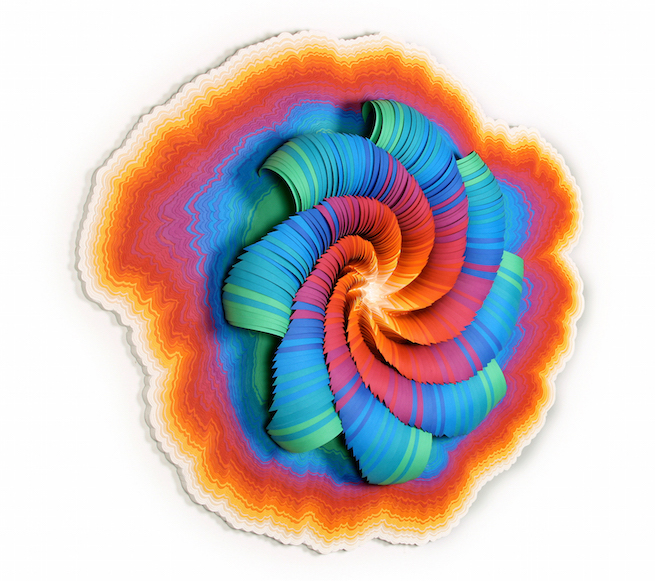THE KALEIDOSCOPE OF JEN STARK: INTERVIEW
By Abigail Yue Wang
Born in Miami and based in Los Angeles, it might be that the American costal heat has something to do with Jen Stark’s audacity in colour. Although many artists have their ways with colours, Jen’s work is the kind that can hardly be mistaken. As all gazes are drawn to the mesmerizing sensation of her spirals and wormholes, paper of Jen’s is no longer frail surface but heartfelt sculptures. Already exhibiting frequently around the US and overseas, soon enough, it may be the exuberance and perplexity of her blossoming paper that in return, cast a spell on America’s contemporary spectrum.
If I haven’t mistaken, you’ve been active as a young artist for nearly a decade, nevertheless you managed to maintain the vibrant quality throughout your work. But have the process and approach changed during these years?
The actual process is similar to how I began. I’ve perfected things like, what tools I use and try to keep getting better quality materials that will last for hundreds of years. I also have interns help me from time to time, which is a great help.
Despite the fact that people expect your work to be created by laser cutting or digitalized methods, they are actually very much meticulously handmade, with demanding precision. Do you usually work with coloured paper or paint the layers as needed?
I usually work with pre-made colored paper. My favorites right now are sheets of drawing paper called Canson Mi-Tientes and Canson Colorline. They are both acid free, fade-resistant and meant to last a very long time.
For the ever-extending wormhole-like sculptures like Cosmic Complex or Vortextural, do you start from bottom up or the other way? Does this direction of working with paper affect the way you perceive a piece?
With these pieces I usually begin cutting the largest shapes first. I free hand it all and don’t have any templates to guide me along the way. Working this way definitely affects how the final shape turns out. I usually have a loose idea of what it will look like in the beginning, but there is always that element of change and surprise since it is all handmade and cut layer by layer.







As you said, you work with acid-free paper to sustain colors for long period of time, the colorful loops in your paper sculptures also spiral into an impression of infinity. There’s an interesting contrast between the everlasting effect in your artwork and the fragility of paper as source material. What do you think?
Yes, I love this contrast and am happy it comes across in my work. I’m interested in time and infinity, and chose to juxtapose this with a very common and seemingly fragile material: paper. Although the material seems very fragile, with the proper care, it can actually hold up quite well and is projected to last hundreds of years.
Most of your work is inspired by nature’s patterns, algorithm, and nonetheless Fibonacci sequence. I believe you must have built some fans in the mathematical world?
Every once in a while I’ll get an email from a mathematician saying “This piece you just created has the same mathematical equation as this figure…” or something like that. I know very little about the world of math but at the same time I’m in awe of it. I believe everything in nature and the universe obeys certain laws, and I believe my work taps into this simple mathematical equation and visually relates to it. I welcome all fans of my work and am so happy that many different kinds of people from all walks of life seem to enjoy it. I’d love to inspire as many people as possible. I think that’s the most an artist can ask for.
They are certainly inspiring to say the least. In fact moreover, it’s very rewarding to see the animations of yours, in which tantalizing patterns come to life as one could only imagine from the more static sculptures of yours. Especially the animation Believer, which is still very puzzling and magical. Without revealing your secret ingredients, could you walk us through the arc of process?
The stop motion animations are simply still images I take of a moving paper sculpture. I use sheets of paper, stack them in a structure, take a photo, move, replace, or cut the paper, then take another photo. I repeat this process for a couple hundred more times. I then play all the images together on a computer and it creates a moving image.
We have been eagerly anticipating new animations from you, any plans for that recently?
Thanks! I don’t have a new animation in the works at the moment, but definitely plan to create another one in the next year or so. Happy you enjoy them!
You first started experimenting with construction paper during study overseas in Aix-en-Provence because it was cheap but full of possibilities. Since then you’ve also worked with wood, kaleidoscopes and architectural space. Will you be exploring new materials and media?
Yes I’m always experimenting with different materials. I want to be able to work with whatever medium I want, and not be restricted to only paper. Recently I’ve created large-scale mural paintings as well as PCV hanging sculptures and am always searching for new materials to help my ideas come to life.
Apart from Tom Friedman, whom you consider very highly in adopting everyday materials, are there any other artists today who have a distinctive take on paper materials in your opinion?
I’m specifically interested in all different kinds of art mediums, not only paper artists. Right now I’m inspired by many artists like: Ara Peterson, Maya Hayuk, Ben Jones, Tara Donovan, Alvaro Ilizarbe, Takeshi Murata and FriendsWithYou to name a few.
All images courtesy of the artist.
